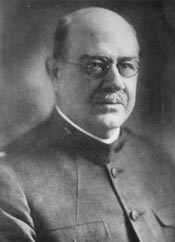ABOUT
NIH HISTORY LIVES HERE
 DR. JOSEPH JAMES KINYOUN, THE FIRST DIRECTOR OF THE HYGIENIC LABORATORY IN 1887. THE HYGIENIC LABORATORY WAS THE BEGINNING OF WHAT IS NOW THE NATIONAL INSTITUTES OF HEALTH
DR. JOSEPH JAMES KINYOUN, THE FIRST DIRECTOR OF THE HYGIENIC LABORATORY IN 1887. THE HYGIENIC LABORATORY WAS THE BEGINNING OF WHAT IS NOW THE NATIONAL INSTITUTES OF HEALTH
The heart of the National Institutes of Health’s (NIH) memory is preserved within the documents and artifacts produced by the institution. The mission of the Office of NIH History and Stetten Museum (ONHM) is to document the present and the past of the NIH and to produce materials that explain the NIH’s history to the public. With the advent of the Information Age, all of us must act to protect and preserve our history because this information is vital to understanding the processes of scientific investigations conducted at the NIH. Information preserved in the ONHM as well as other repositories is of inestimable value to researchers.
Documents, instruments, and reports, for example, provide a unique testimony to the achievements of the collective work done at the NIH since its inception in 1887. The subjects cover many areas—from policy to finance, public relations, and, of course, biomedical discoveries. Just as the correspondence of an author can shed light on the origin of a seminal book, so too can the correspondence or laboratory equipment of a scientist, clinician, or administrator help explain his/her particular work.
The history of the biomedical sciences is also the history of an organized profession. The rise of new fields of research, the influence of new technologies, the changing roles of academic and scientific research, the growth of professional organizations, and the patterns of mentorship are all important elements of the social and institutional history of science at the NIH.
The Office of NIH History has both an archives and a museum. The archives is interested in unpublished documentation including laboratory notebooks; professional and personal correspondence; diaries; successive drafts of publications; course materials, especially for newly developed courses; clinical trial materials; patent applications; speeches; meeting minutes; blueprints; and audiovisual materials. The archives also maintain a large photograph collection.
The Stetten Museum collects scientific instruments and technologies such as gene sequencers and centrifuges, with an additional focus on instruments developed at the NIH. The Museum also collects non-scientific items that place the NIH in a historical context such as paintings, clothing, and cornerstones.
The Office of NIH History welcomes the opportunity to evaluate materials or objects for donation. Due to space constraints, the Office is selective in the types and formats of donations we can accept. If prospective donations fall outside the scope of our collection focus, we will gladly advise you on suitable repositories for your materials.
